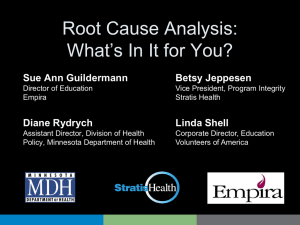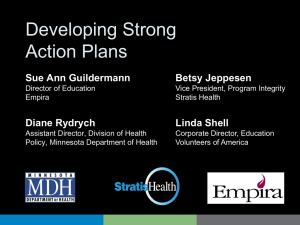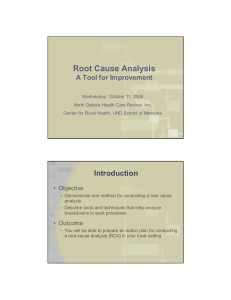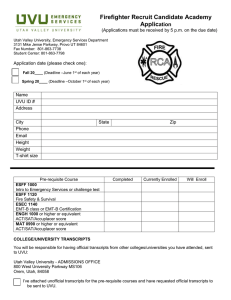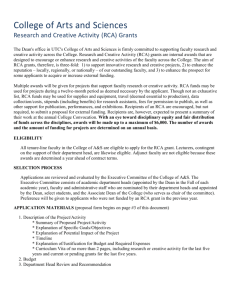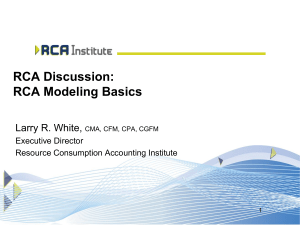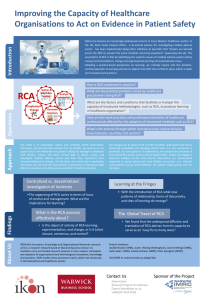Critical Event Review - Minnesota Department of Health
advertisement
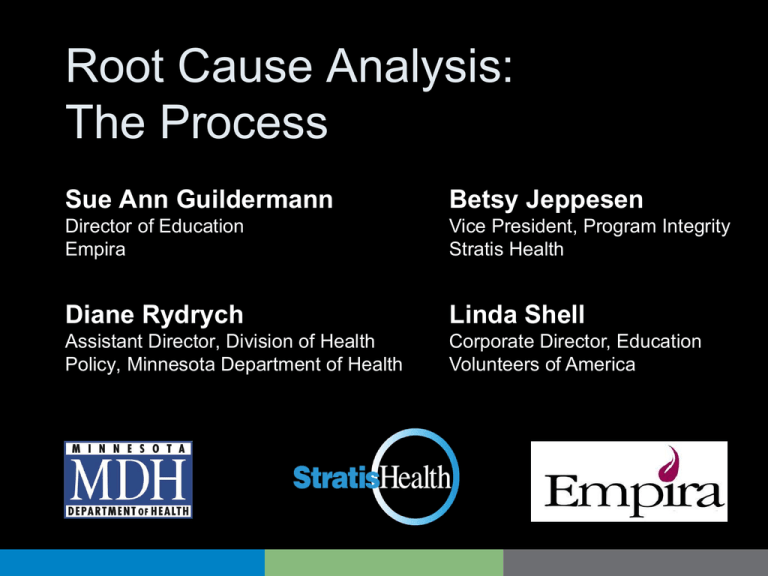
Root Cause Analysis: The Process Sue Ann Guildermann Betsy Jeppesen Director of Education Empira Vice President, Program Integrity Stratis Health Diane Rydrych Linda Shell Assistant Director, Division of Health Policy, Minnesota Department of Health Corporate Director, Education Volunteers of America Why do you think this resident falls down in about 35 minutes? Clue #1: What are we going to cover? • Considerations for conducting a Root Cause Analysis (RCA) • Steps in the RCA process When RCA could be considered • • • • Events with serious outcome for resident Repeating incidents Near misses/good catches Examples: – – – – Falls Medication errors Pressure ulcers Plan of care not followed When the information has been gathered… Two approaches to RCA 1) An RCA team uses information from individual interviews of the multidisciplinary staff involved in the event to uncover all possible causes and systems that led to the event. 2) As soon as possible after the event, a group meeting that includes the multidisciplinary staff involved in the event is conducted to uncover all possible causes that led to the event. Option #1 – staff interviews and separate group RCA • Staff collect initial information about the event • All staff who are on scene or have had contact in last 4 hours/shift are interviewed • Within 1 week, information is brought to the multidisciplinary committee Option #2 – RCA meeting with staff involved in the event • Information to be used in the meeting is gathered: – incident report – medical record account of the event – staff drawings/notes of the event • Time line of the event is created • Meeting is held within 48 to 72 hours Other Considerations – Determine who sets up the staff interviews and/or group meeting – Consider space needed for interviews or meetings and confidentiality of the conversations – Never compromise resident safety Key players • Staff from departments/units directly and indirectly involved in event • Nursing administration • Medical director, physician, provider • Quality representative • Administrator • Facilitator/interviewer • Pharmacy, therapy, social work, others identified Coaching staff • Initiated prior to setting up interview/meeting if staff member has not participated before • Participation is a learning opportunity • Participation is a chance for staff to tell their story • Emphasis is on improving the system Clue #2: This 88 year old man has atherosclerosis. He was admitted from the hospital 10 days ago following an MI when an angioplasty was performed and a coronary artery stent was inserted. He has vision and hearing impairment. His daily meds include: Lopressor, Coumadin, Zocor, Lorazepam, a Multi-vitamin and a stool softener. Facilitator/Interviewer • Team training/group skills – Clinical background helpful, but not required – Listening skills – uncover the story behind the event – Analytical skills – conversational/timeline versus investigation data gathering Facilitator/Interviewer (continued) • Strong boundaries – Bring people back to focus – Manage emotion (fear/anger) in the interview and at the table – Identify and draw out people – Engage entire team to give their perspective • Support everyone’s style Recorder • Facilitator may be recorder as well • In group meetings – The facilitator is listening for to the way staff members are speaking, which may lead to further exploration of a point for finding – The recorder can then capture what they are saying Ground Rules • • • • • Confidentiality Titles left at the door All members must be active participants No such thing as a bad question Systems and process focus – No blaming or finger pointing • Foster creativity – “You” have the solutions Telling the Story • Obtain the details of what happened • What did you see, hear, etc? • Encourage people to share – Identify opportunities and gaps as the story is presented – Why, Why, Why? • What was the resident’s position? Where was the equipment? Don’t stop here. • Why didn’t the process work as expected? • What was different this time? Use of triage questions in the RCA process • Helps team understand event • Assures a thorough investigation – “buckets” – Human factors • Staffing – Communication/information – Equipment/environment – Uncontrollable external factors – Training – Rules, policies, procedures – Barriers Clue #3: The resident was found on the floor next to his bed. When asked, “What were you trying to do?” He answered, “I couldn’t find my glasses. So, I got up to look for them.” Continuing the RCA process • Identify factors that may have led to the event – Identify system and process gaps – Identify opportunities for improvement • Participant feedback on how to improve systems is critical – What could have been done differently? • Develop an action plan – – – – Based on findings With target dates Responsible party Monitoring/measurement plan • Follow-up Spread the success/knowledge • Share with staff and administration – Go beyond interdisciplinary care team • Share learnings and collaborate with other facilities Root Cause Analysis summary • To be thorough, an RCA must include: – Determination of human and other factors – Identification of related processes and systems that contributed to the event – Analysis of underlying causes and effects – a series of whys? Questions? Sue Ann Guildermann Director of Education Empira 952-259-4477 sguilder@empira.org www.empira.org Betsy Jeppesen Vice President, Program Integrity Stratis Health 952-853-8510 or 877-787-2847 bjeppesen@stratishealth.org www.stratishealth.org Diane Rydrych Assistant Director Division of Health Policy Minnesota Department of Health 651-201-3564 Diane.rydrych@state.mn.us www.health.state.mn.us/patientsafety Linda Shell Corporate Director, Education and Learning Volunteers of America 651-503-8885 lshell@voa.org Protecting, maintaining, and improving the health of all Minnesotans. Stratis Health is a nonprofit organization that leads collaboration and innovation in health care quality and safety, and serves as a trusted expert in facilitating improvement for people and communities. Clue #4
